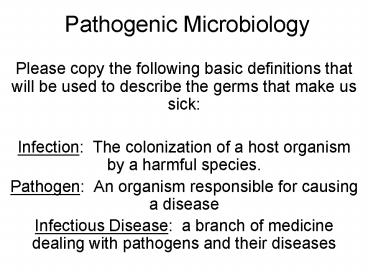Pathogenic Microbiology - PowerPoint PPT Presentation
1 / 20
Title:
Pathogenic Microbiology
Description:
Pathogenic Microbiology Please copy the following basic definitions that will be used to describe the germs that make us sick: Infection: The colonization of a host ... – PowerPoint PPT presentation
Number of Views:163
Avg rating:3.0/5.0
Title: Pathogenic Microbiology
1
Pathogenic Microbiology
- Please copy the following basic definitions that
will be used to describe the germs that make us
sick - Infection The colonization of a host organism
by a harmful species. - Pathogen An organism responsible for causing a
disease - Infectious Disease a branch of medicine dealing
with pathogens and their diseases
2
The Germ Theory of Disease
- This old, dead, white dude named Robert Koch
developed scientific proof that specific
microorganisms cause specific diseases in 1890
3
Kochs Postulates
- This is how a specific organism can be proven to
be the causative agent of a specific disease. - Isolate and identify organism from sick host
- The isolated organism causes the same illness if
given to a new host, and can be isolated from the
second host once again.
4
Types of Pathogens
- Infectious diseases may be caused by bacteria,
viruses, eukaryotes, and other agents. - There are an amazing number of different
pathogenic species, and they can make you sick in
a variety of ways.
5
Top 10 Infectious Diseases 2002
1 Lower respiratory infections12 3.9 million 6.9 (pnemonia, influenza, etc.)
2 HIV/AIDS 2.8 million 4.9
3 Diarrheal diseases13 1.8 million 3.2
4 Tuberculosis (TB) 1.6 million 2.7
5 Malaria 1.3 million 2.2
6 Measles 0.6 million 1.1
7 Pertussis 0.29 million 0.5
8 Tetanus 0.21 million 0.4
9 Meningitis 0.17 million 0.3
10 Syphilis 0.16 million 0.3
6
Viruses
- A virus is a tiny (10-300 nm) infectious agent.
Viruses are not cells. - Most viruses have only a few genes (flu has 10.
you have gt30,000) - Viruses cause disease by entering host cells,
reproducing, and then causing the cell to burst.
7
The size of things Eukaryote v. prokaryote
8
The Size of Things Prokaryote v. Virus
9
Viral Replication Ribosome Hijacking
- All viruses are pathogens they cannot reproduce
by themselves
10
Common Viral Diseases
- Common Cold
- Influenza
- Chickenpox
- Herpes
- Hepatitis
- HIV
- Many, many others
Chickenpox
11
Do Now
- Make a list of the specific information you
should include in the abstract section of the
upcoming Winogradsky column lab report. - I. Abstract. The abstract of your report should
quickly describe your experiment, its
significance, and its results. It will include 3
parts - A. Background information about the topic,
including basic information about processes,
organisms, or other principles underlying the
experiment. - B. A description of your experiment, including
the hypothesis and predictions underlying your
experiment. To put it shortly, explain what you
expected to find, how you expected to find it,
and why you expected what you did. - C. A summary of your results. What did you
find out?
12
M M
- This section should be a detailed account of what
it is you did, the equipment you used, and all of
the procedures you followed. Someone following
your materials methods should b able to
perfectly repeat your experiment and produce the
same results. Be detailed!
13
Data Results
- This section will include all of your
observations, measurements, data, graphs, charts,
calculations, and any other data or analysis you
perform.
14
Conclusion
- What did you discover, prove, or see an example
of? How do you know? Did anything go wrong?
How could the experiment be improved? Why are
your findings important? What biological concept
has your experiment demonstrated?
15
Bacteria
- Most bacteria are noninfectious
- Some are opportunistic pathogens cause illness
in weak and sick individuals. - Others are obligate pathogens always cause
disease to survive
16
How Bacteria Cause Illness
- Most bacterial diseases are caused by toxic
chemicals called exotoxins or endotoxins that the
bacteria produce. These toxins can disrupt or
destroy nearby cells
17
Bacterial Diseases
- Leprosy
- Tetanus
- Whooping Cough
- Typhoid Fever
- Cholera
- Plague
- Tuberculosis
- Meningitis
- Bacterial Pneumonia
- Anthrax
- Botulism
- Bacterial Dysentry
- Diarrhoea
- Food Poisoning
- Gas Gangrene
- Syphilis
- Diphtheria
- Gonorrhoea
- Typhus Fever
18
Protists Fungi
- Eukaryotes can be pathogenic too!
- Unicellular parasites can live within cells and
tissues, causing diseases such as - Toxoplasmosis
- amoebic meningitis
- Malaria
- Trypanosmiasis
- Leishmaniasis
- amoebic dysentery
- diarrhoea caused by Cryptosporidium spp. or
Giardia intestinalis (lamblia)
19
Worms
- Roundworms and flatworms are two major classes of
multicellular human pathogens but well learn
more about them in the future.
20
Other Stuff
- Still other diseases like Mad Cow Disease are
caused by prions. - A prion is an infectious agent that is a single
protein molecule

